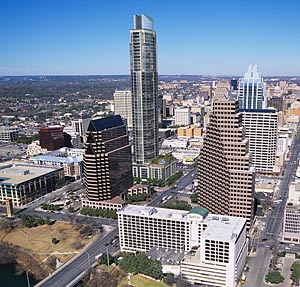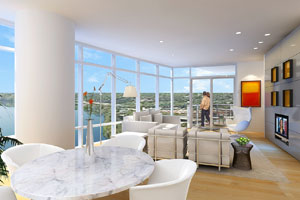At 680 feet tall, the Austonian, designed by Houston-based firm Ziegler Cooper Architects, will be the tallest building in Austin when it’s completed in 2010.
Currently at the halfway point, the 56-story elliptical steel, aluminum, concrete, glass, and limestone-clad building will serve to add to Austin’s skyline with a somewhat softer (and less controversial) top than the pointy ends of the current highest building, the 515-foot, 33-floor Frost Bank Tower, built in 2003 by Duda/Paine Architects and HKS and sometimes referred to as “giant nose-hair clippers.”


According to Scott Ziegler, the Austonian’s design principal, the illuminated zenith of the new building will resemble a “lamp of knowledge”—a nod to the prominence of Austin’s University of Texas. “We didn’t know when we started how tall it would be,” says Ziegler, “But we knew that to encourage density downtown Mayor Will Wynn had lifted the 8-to-1 floor-to-area [FAR] ratios and that negotiations were in progress to go as high as we could. The Austonian’s FAR is 18-to-1.”
The mayor’s stated plan in 2006 was to get 25,000 people living downtown—discouraging sprawl and attracting retail and hospitality to the city’s core. It’s worked to some extent. With around 10 downtown high-rise condo projects in the works, Austin is poised to either gain a vibrant city center, or be stuck with a glut of empty units.
Either way, the 188 units of the Austonian promise to be both luxurious and surprisingly sustainable. The building’s developer, Benchmark Development, which is the Austin-based subsidiary of Grupo Villar Mir, the largest Spanish, family-owned industrial group, is seeking a four-star rating from the city’s Energy Green Building Program, equivalent to the LEED Gold Rating from the USGBC.
Low-e glass, low-flow toilets and showerheads, and Energy Star appliances are used throughout, as are low-VOC emitting adhesives, sealants, paints, and coatings. Sensors and dimming ballasts will help keep lighting on only when needed. The building’s HVAC system operates using the Austin chilled water system rather than electricity or individual HVAC units. Reflective roof surfaces and skin will combat the urban heat-island effect, while native plantings will be watered from tanks storing 14,500 gallons of rainwater. Many of those plants will thrive in an urban garden on the 10th floor, which has a 75-foot lap pool, fountains, a reflecting pool, and a secured dog park.
The building’s other amenities include touch-screen climate/lighting/media/security controls in each unit, and public space for residents, such as a fitness club on the top floor and a screening room with seating for 12. The 55th floor features a “sky lounge” with 6,000 square feet of entertaining space. Up to 18,000 square feet of street-level retail or restaurants is planned as well, and possibly more on the mezzanine level.
With the smallest units at 1,200 square feet starting at $559,000, and more than 100 units selling for over $1 million, it remains to be seen if the country’s stunted economy will keep buyers away from downtown Austin. Regardless, the Austonian’s construction progress has not faltered.



Post a comment to this article
Report Abusive Comment